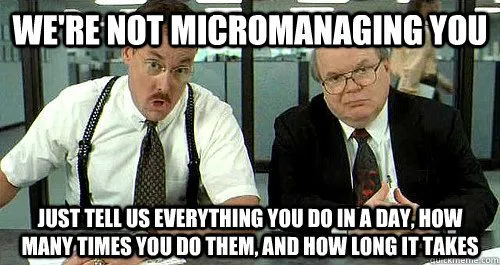If there’s ever been any constants in the technology world, these are them. Time and time again, I see people and teams get derailed when these principles aren’t followed.
2. Empower your team and don’t micromanage.
If you were to ask 100 leaders what it means to “empower” teams, you’d almost certainly get at least 30-40 different answers and a ton of variation in the ones whose answers are relatively close. And, I’d wager that their answers likely differ quite a bit from those of 100 individual contributors on those teams.
Empowerment is one of the most thorny topics I’ve ever come across, and can be a really difficult hurdle for leaders to navigate with their teams.
Merrian-Webster defines empowerment as ” the act or action of empowering someone or something: the granting of the power, right, or authority to perform various acts or duties.” That makes sense but a core concept that is missing from every definition I can find is “trust”. Trust is the cornerstone of the foundation of empowerment. If a leader doesn’t trust the team, they will have a tendency to micromanage things while still vocalizing “I hate micromanagement”. If the team doesn’t trust the leader, then they can often not reach their true potential as they will hesitate to act with intention and continue to require a certain amount of direction and hand-holding from their leader.
In my experience I have deduced there are several key steps to truly empowering teams:
- Ensure the right team is in place – in order to establish a necessary level of trust, you have to feel like you have people on your teams that you can rely on. This is very often one of the most complicated parts of being a leader. You have to be able to look objectively at your talent pool and make good decisions about any changes you need to make. This is where I see so many leaders fail. We are human and by and large, we hate to negatively affect other people’s lives, and so many times I’ve seen leaders retain the wrong talent because of how it feels.
- Clearly communicate expectations – No one should have to second guess what your expectations are, or have some kind of moving target they are trying to satisfy. These expectations include communication patterns and timings (e.g. I hate to be blindsided…I should have the info before anyone else outside our team), problem resolution steps, processes for handling work interruptions, etc.
- Encourage and practice transparency – As I’ve said before, your teams have to be able to trust you won’t shoot the messenger, that they can come to you with whatever they need and you will attack the problem, not the person. This also goes both ways…you have to be as transparent as possible with your teams in order to facilitate their trust in you.
- Create autonomy and trust, but verify – This is probably the most important one! Empowering teams means, to a large degree, giving them the authority to make decisions instead of you. Not only does the team have a voice, but they also have the ability to specifically decide and influence things, and that critically, you have their back. But there is a pitfall here to be aware of: blind trust, without verification, can doom you. I have literally led a team who essentially told me to go pound sand when I started digging into their work. “The last leader just trusted us to do our job. You need to just see how we do things and leave us alone and let us do our job too.” Had I acquiesced to that, I would have made a tragic mistake as the work they were doing was architecturally unsound and would have created a mountain of tech debt and problems in the very near future. It’s important to note that how you approach verification will absolutely determine the impact it has on those whose work you are checking. Most people I’ve ever worked with are sensitive to anyone critiquing their work. There is an art in doing so and how you do it can make or break your relationships with them.
It’s really important to note that none of these steps stands alone. They are all intertwined with one feeding into another and every one of them hinging on the concept of trust.
One of the best ways I have found to measure the degree of success of my own team empowerment is to ask myself and my teams a question that every leader should ask themselves about their teams: “If I get hit by a bus tomorrow, will my teams be able to continue operating as normal without me?” The short answer that you are looking for is ‘yes, I could cease to exist and they could continue to work as normal.’ If there is any kind of “well, for the most part”, then it’s likely you still have some work to do.
Maybe this would be a good time to ask this question of yourself and your teams.
